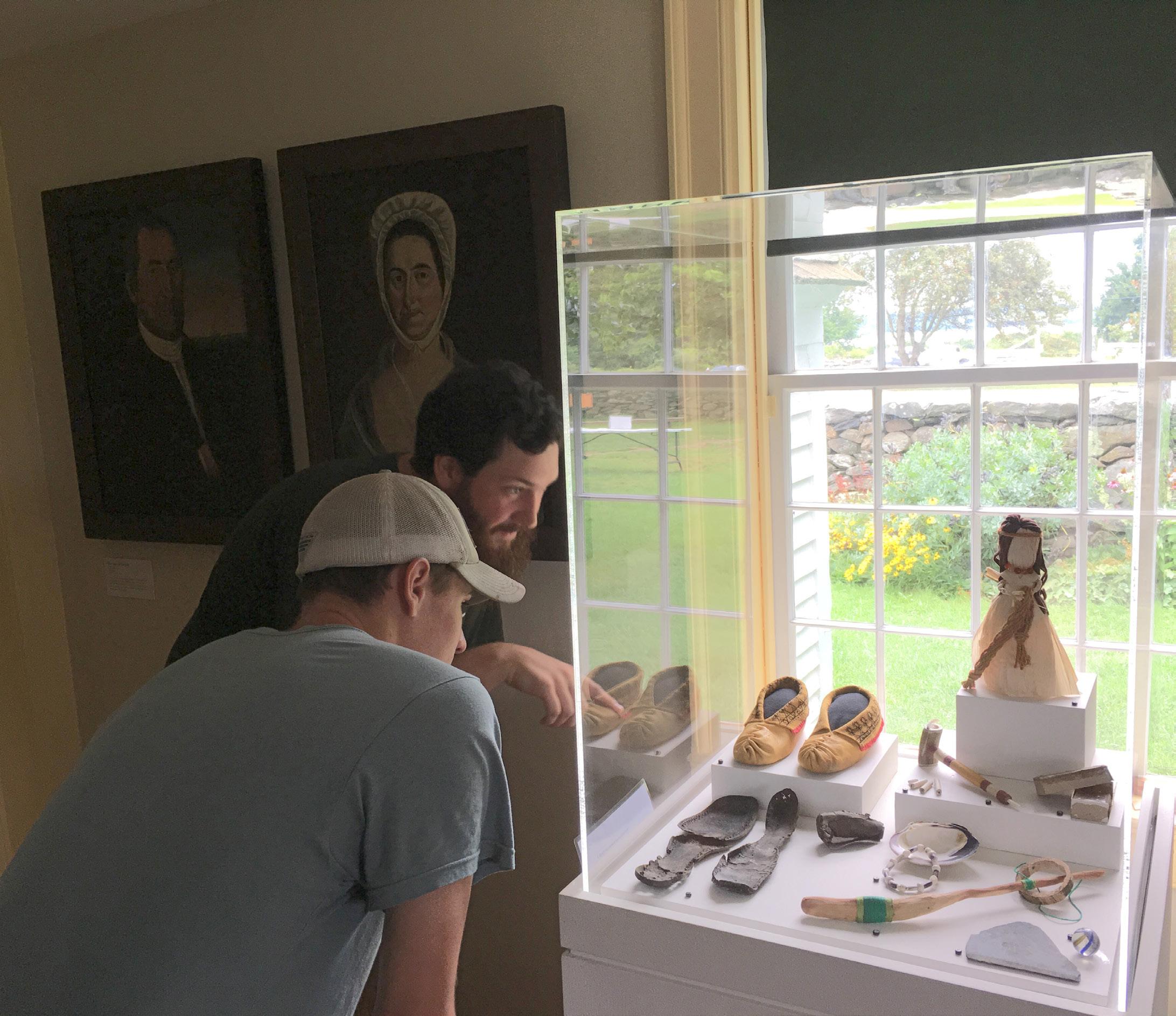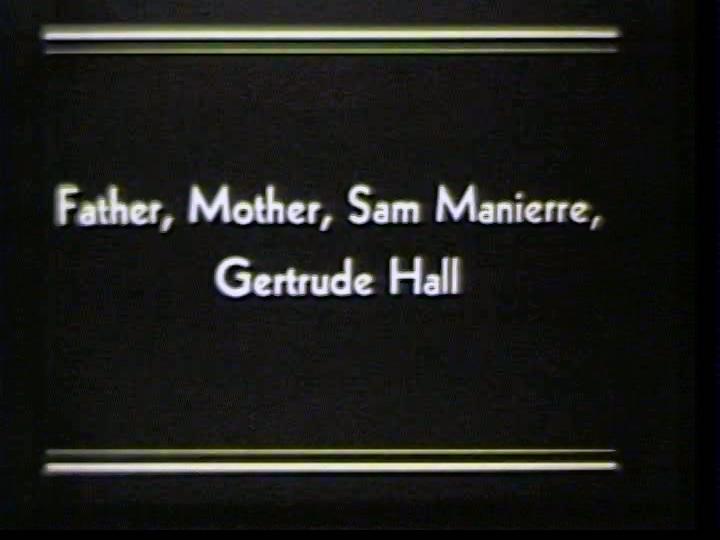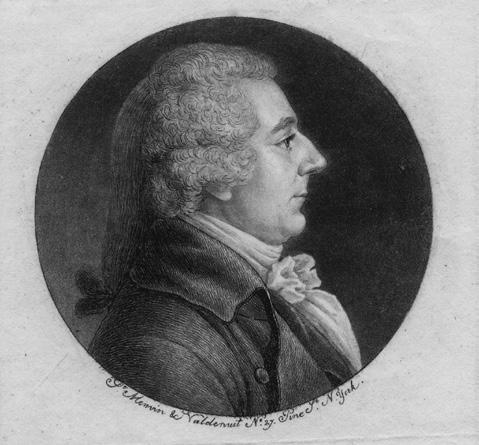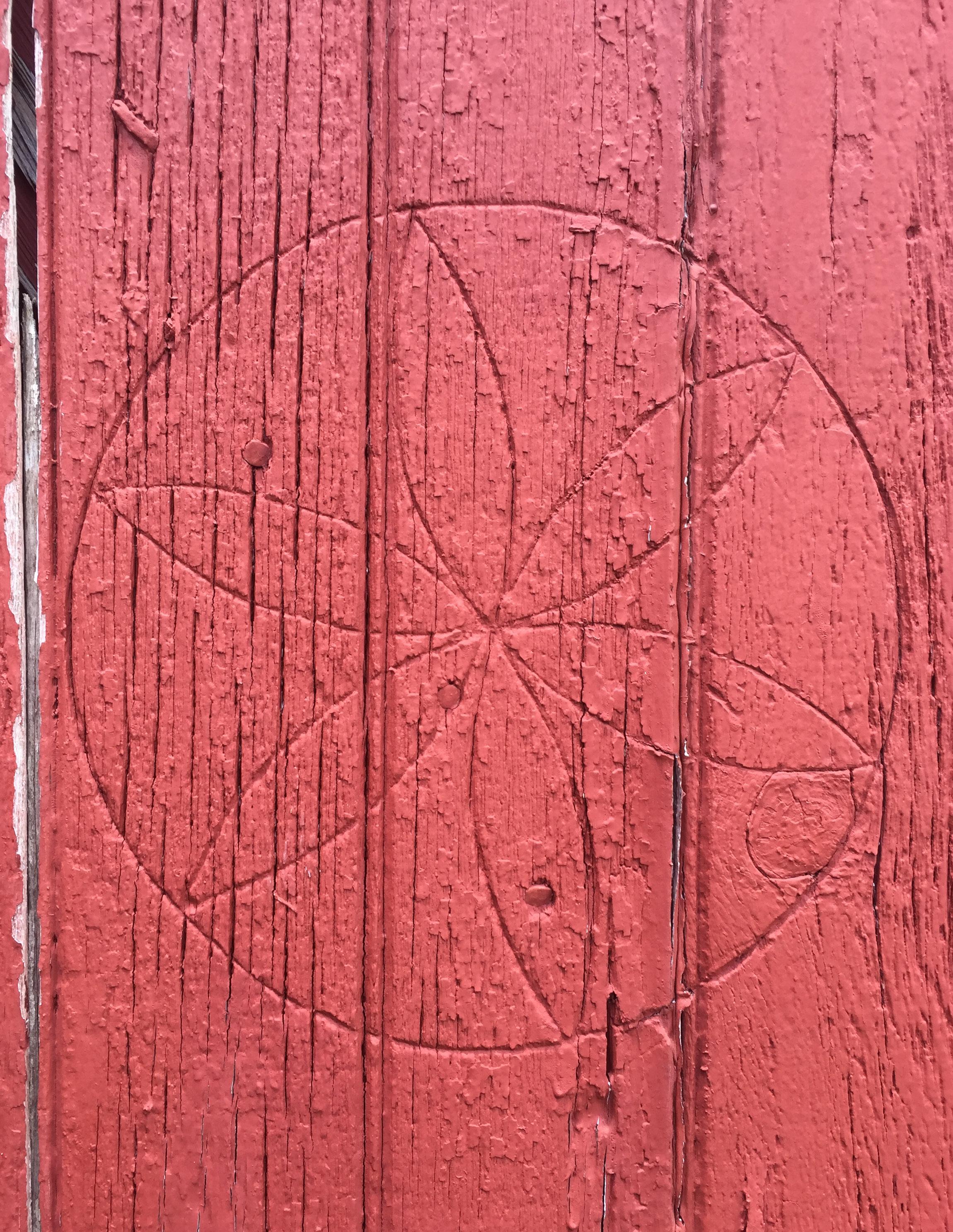
11 minute read
Magic Markings
M a g i c M a r k i n g s
by MICHAEL J. EMMONS JR. A doctoral candidate in preservation studies, Michael J. Emmons Jr. is an architectural historian at the Center for Historic Architecture and Design (CHAD) at the University of Delaware. He is the founder of the Early American Graffiti Project.
Could symbols found in early New England houses have protective meaning?
When you climb the steep stairs to the second level of Historic New England’s Jackson House and enter the shadowy rear sleeping chamber, you might notice (once your eyes adjust to the dim light) on one of the plank wallboards a neatly inscribed symbol formed of overlapping circles with a flower or star in the middle. One might assume this sketch is just an odd, one-of-a-kind doodle. Yet the presence of such a symbol at this c. 1664 house in Portsmouth, New Hampshire, is far from unique. In fact, even among Historic New England’s thirty-seven properties, at least two others feature similar markings, both in Massachusetts: Gedney House in Salem and the Spencer-Peirce-Little farmhouse in Newbury.
Similar markings seem to be just about everywhere once you start looking for them, at least in eighteenth- and early-nineteenthcentury buildings. During fieldwork for my dissertation (which examines all sorts of early American graffiti) over the past seven years, I have encountered dozens of sites featuring these symbols. They are found on walls, doors, fireplace lintels, stairs, attic beams, and even floorboards, and they probably exist in hundreds of early American houses. Apparently created (most of the time) with compasses or carpenters’ dividers, the symbols typically consist of an inscribed outer circle enclosing six pointed “petals” that stretch from the circle's center to its perimeter, thus resembling a flower. This leads many people to call the symbols “daisy wheels” or six-petaled rosettes, though others have labeled them “hexafoils” or six-lobed stars. Whatever you call them, they seem charged with meaning, and cloaked in mystery.
Explanations for daisy wheels found in historic houses vary almost as widely as the symbols themselves. Many suggest they are “witch marks”—left not by witches but by people trying to keep them at bay. Others argue that they are carpenters’ sketches, used for laying out the dimensions of buildings during construction. Some people dismiss both theories, claiming that the symbols are nothing more than children’s doodles.
So, what are we to make of these enigmatic markings? Even after years of first-hand observation and historical research, I remain unconvinced that any single explanation provides the answer. Instead, I see merit—as well as problems—with all of the various explanations and I urge careful consideration of each individual marking based on its unique location and context, the material evidence in the building, and the history of the people who occupied it.
The most common explanation for these symbols is that they are “witch marks” or “hex signs,” protective inscriptions to guard one’s house, and family, against misfortune (and perhaps actual witches). Though somewhat strange to modern sensibilities, the idea of using symbols for protection from supernatural forces held currency in seventeenth- and eighteenthcentury New England. Persecutions
for witchcraft were widespread throughout Europe in the sixteenth and seventeenth centuries, and belief in witches and witchcraft reached a fever pitch in New England with the 1690s hysteria and the witch trials in Salem, Massachusetts. Though such fears were dissipating even at the time of those trials, anxieties about malevolent forces, mysterious illnesses, and supernatural afflictions (even fires and lightning strikes were suspect) persisted into the eighteenth century and beyond. In an era when distinctions were blurry between the visible and invisible, the natural and spiritual, and even good and evil, it is not surprising that people sometimes sought to protect themselves through
Detail of an image from a c. 1594 leaflet titled Trier Hexentanzplatz (Witches’ Dance Floor), published after the largest witch trials in German history. Note the fireplace mantel with crossed-out markings, which are possibly apotropaic, and the victorious witches at the top of the chimney and flying into the fireplace.

rituals that might be considered superstitious today—reaching beyond traditional prayer and other mainstream religious practices to engage in folk traditions and rites that lent a sense of extra security.
Since houses served as a physical barrier between the public and private spheres, as well as between controlled and uncontrolled spaces, walls were an obvious location for attempted spiritual fortification. Openings of houses were believed to be especially vulnerable entry points; perhaps this is why daisy wheels are often clustered around fireplaces, windows, and doors. Yet, in 1597, King James VI of Scotland (who would become King James I of England) published a book titled Daemonologie—less well known than the Bible he

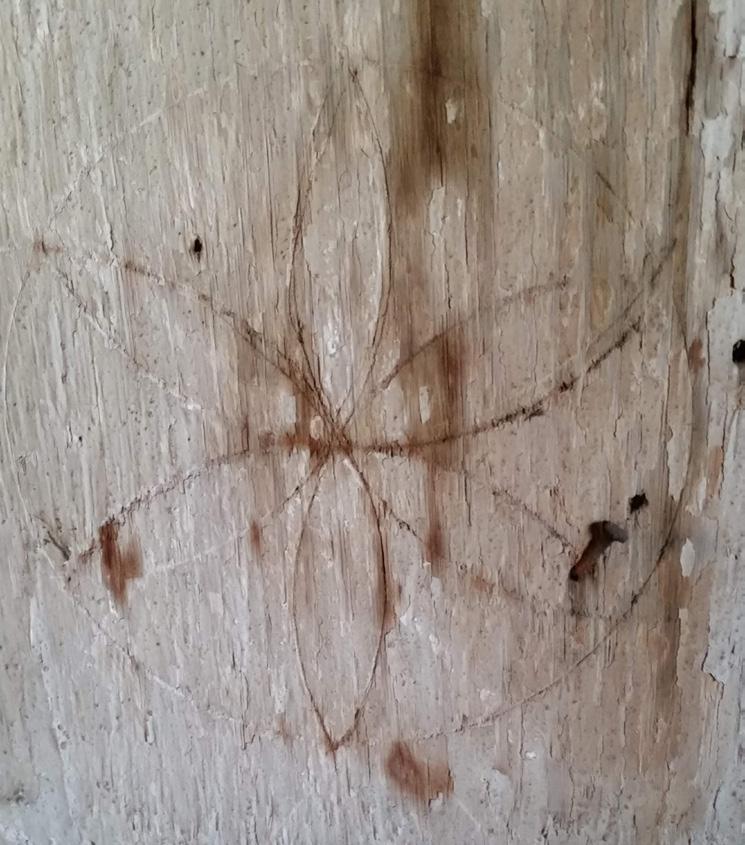
clockwise, top left This assemblage of daisy wheels features one made on a door at Joseph Churchill House (c. 1662) in Plymouth, Massachusetts. The second example is inscribed in plaster on an upstairs wall at Pettengill Farm (c. 1800) in Freeport, Maine. The last carving is at Historic New England’s Gedney House (1665) in Salem, Massachusetts.

sponsored—in which he shared a widespread belief that evil spirits would “come and pierce through whatsoever house or church, though all ordinary passages be closed, by whatsoever open[ing] the air may enter in at.” In other words, “ordinary passages” were susceptible, but so were even narrower spaces under doors, cracks between floorboards, and small holes in attics. With such potential threats looming, if one could hedge one’s bets by scratching a symbol on a fireplace lintel or on a floorboard in a child’s room, why not give it a try?
At many sites in England and the United States, daisy wheels have been found in suggestive locations, and sometimes alongside other markings believed to be protective, including fylfots, the evil eye, Marian marks, and intentional candle burn marks. In addition to markings, the related phenomenon of stashing ritual deposits inside walls or under thresholds—including worn shoes, animal skulls, or iron implements—
has been identified after discoveries at many historic houses in New England and elsewhere. Some sites, including a c. 1755 house in the western Massachusetts town of Williamsburg, contain both daisy wheels and ritual deposit items. Collectively, these practices—and the objects enlisted to keep away evil or bad luck—are called “apotropaic,” from a Greek word meaning “to turn away.” Some of these practices (including daisy wheel inscriptions) seem to have lasted well into the nineteenth century—and even to the present, if we consider that people still attempt to protect doorways by hanging horseshoes above them, chalking them with inscriptions during Epiphany, or attaching mezuzahs on doorposts.
Still, there are reasons to remain cautious about interpreting all daisy wheels as apotropaic markings, especially the impulse to proclaim them all “witch marks.” It is frustrating—and perhaps revealing— that no written records have ever been discovered that confirm the use of these symbols for spiritual protection (there are first-hand accounts, however, about people protecting New England houses with horseshoes above doors or fresh bay leaves placed around walls).
The presence of daisy wheels on fireplace lintels and around windows and doors might be explained by the fact that before electrification, it was difficult to see inside dimly lit houses—open doors, windows, and burning fireplaces might provide the best light to carve by. Still, many daisy wheels are not near openings that might be perceived as vulnerable and are often in attics, on floorboards, on exposed beams tucked away in corners, and in the middle of walls. Further, daisy wheels are sometimes found on buildings constructed in the
mid-1800s and later, when witchcraft beliefs had largely faded from popular consciousness. In these later periods, if daisy wheels were charged with any meaning it was probably as just a good-luck charm or house blessing. If so, the symbol’s persistence as an attractive charm might also help explain its frequent appearance as decoration on many objects, from gravestones to Pennsylvania German barns to furniture to woodworking tools.
The second most common theory about daisy wheels is that they are the work of carpenters who used these complex geometric symbols for measuring and designing during the construction process. This explanation is appealing for several reasons. For one, the architecture of even common buildings incorporates geometric shapes and proportions, and it was essential for master builders to have a command of basic geometry (and the ability to calculate), since they often doubled as the architect/designer of vernacular structures. Some researchers have transposed daisy wheels onto scaled-down, measured drawings of buildings and found intriguing correlations with some of the building’s framing members and other architectural elements.
Builders did sometimes use building parts to sketch makeshift architectural plans or to make calculations. Scratched or chalked drawings laying out windows, stair balusters, and framing plans have been found in many buildings during restoration work, hidden on the backs of wallboards or on the bottoms of stair treads. It is also worth noting that, of all early Americans, builders were the most likely to carry the tools necessary to create circular designs— like carpenters’ dividers, race knives, or compasses. Lastly, builders also had access to all the building parts where these symbols would eventually be discovered including, for example, elevated posts or beams in attics, which would be difficult for anyone to reach after construction (attics and floorboards also frequently contain carpenters’ marks and lumber tally marks, composed of Roman numerals and slashes that are sometimes mistaken for apotropaic markings).
There are, however, many problems with attributing daisy wheels to housewrights. Architecture books from the eighteenth century contain much discussion of geometry and design, and even illustrations with many geometric shapes. However, I am not aware of a single book from that century that portrays a daisy wheel or explains how to use one in construction. Structures designed using geometric principles inherently contain universal proportions and measurements; they might correspond, even accidentally, to various points on a daisy wheel, even if one was not used in the design process.
Many daisy wheels were clearly executed long after a building was constructed. They are sometimes scratched into multiple layers of paint, suggesting that decades had passed after construction before the daisy wheel was made. They are also frequently carved on highly visible, finished surfaces that a carpenter would not have marred with a scratched-in symbol. In addition, many daisy wheels are poorly executed—drawn with incorrect proportions, with an unsteady hand, or with a tool that was not ideal for the creation of a crisp symbol. If we assume that most carpenters would have had good tools for such a purpose and the dexterity that came along with being a craftsman, as well as the (supposed) need to create an accurate, proportional daisy wheel on which to base a design, how can we explain sloppy, crude, or unfinished daisy wheels?
The answer, probably, is that many daisy wheels are simply doodles, made by young adults or even children. Too often we forget the playfulness of historical actors—that they, too, got bored and liked to create beautiful things. These mesmerizing sketches from centuries ago might be the equivalent of the popular Spirograph drawing toy in the twentieth century. This would also help explain the wide variation of compass-drawn circular symbols, which sometimes transcended the simple daisy wheel to form elaborate, interlocked designs
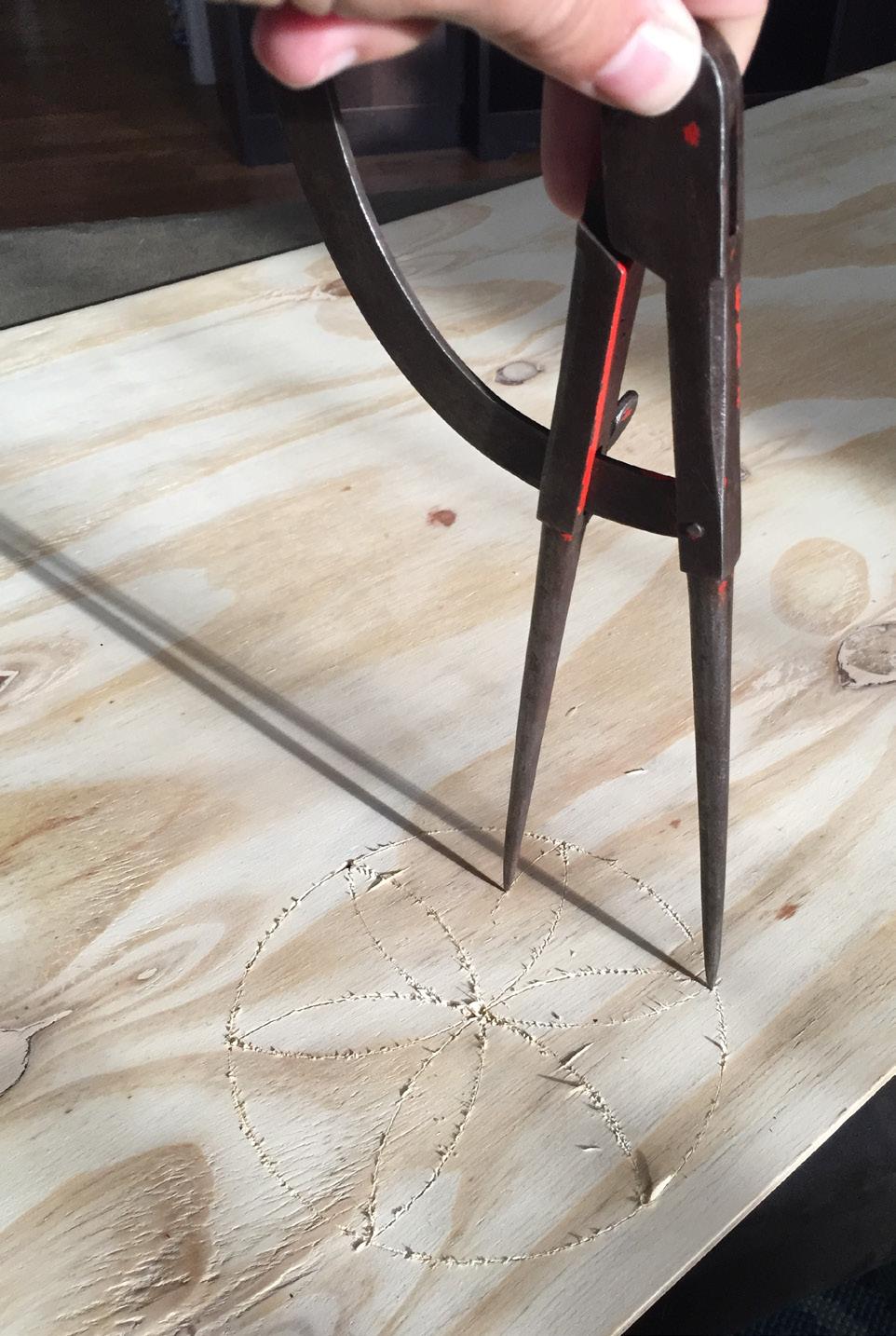
A door in the c. 1686 Old Ordinary, in Hingham, Massachusetts, (a close-up of the panel is on the right) features an array of compassdrawn circular symbols including concentric circles, conjoined circles, and four-petal daisy wheels, as well as zig-zags or lightning symbols, and a possible Marian mark scratched on the opposite side. Marian marks often consist of the letters M and double V, and have been associated with the Virgin Mary.
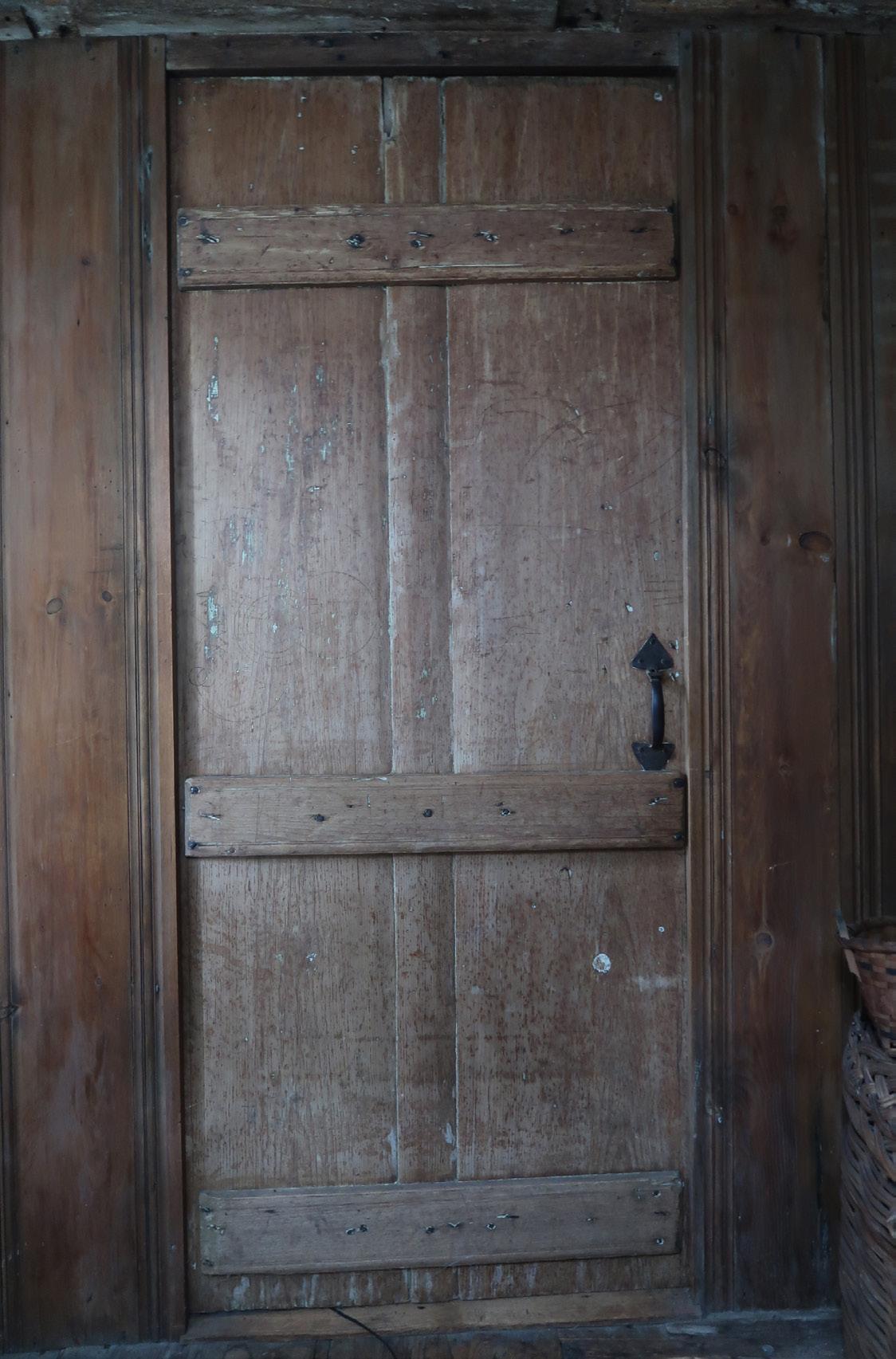

that involved dozens of circles and arcs. Sometimes a single house will feature a dozen different types of circular designs ranging from concentric circles to daisy wheels to clusters of plain circles to wreaths or chains created with a compass, or similar caterpillar-like images. These smatterings of circular designs are sometimes found alongside other sorts of playful graffiti, including carvings of people, buildings, or animals.
Yet, it would be a mistake to dismiss daisy wheels as meaningless doodles, even in the cases when they are most likely doodles. It is my belief that these markings are significant for a variety of reasons, and they add a valuable layer of meaning to many historic sites. They remind us of the real connections people had with the places they occupied, and like other historical graffiti,
they help historians reanimate these structures with the otherwise undocumented actions and worldviews of the people who once built, lived in, or visited them. Beyond just daisy wheels, the frequent circles and circle-based drawings discovered at so many historic houses almost certainly possess a significance beyond mere coincidence. Whatever their meaning—whether they were intended to ward off misfortune, help construct a building, or provide amusement—these markings are cultural artifacts that deserve additional study and preservation. In the meantime, they will continue to offer allure and mystery at historic sites throughout New England.
Michael Emmons studies all types of historical graffiti and welcomes hearing from readers about their discoveries. Contact him at mjej@udel.edu.



